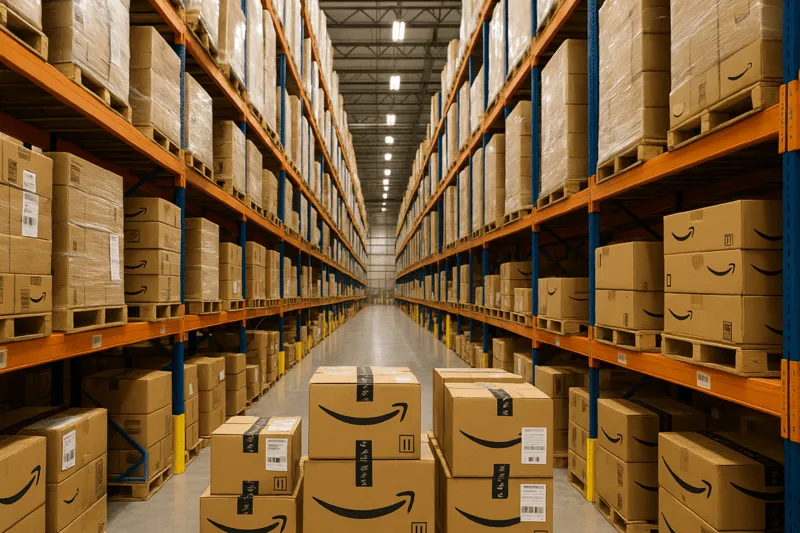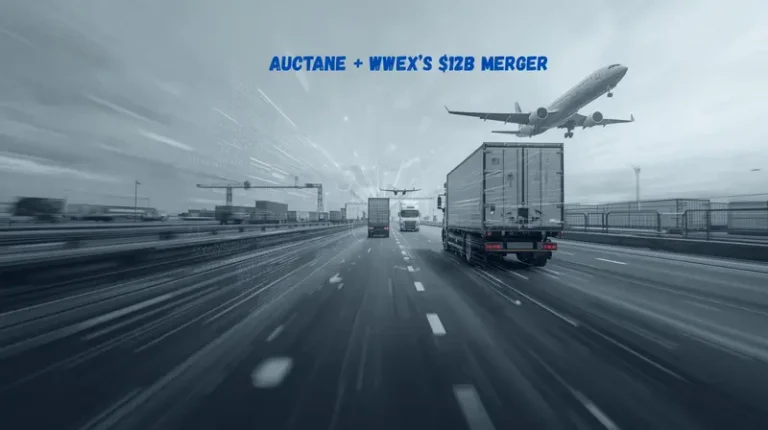Amazon AWD: Benefits and Disadvantages of the Warehousing and Distribution Bulk Storage Solution

Last updated on July 15, 2025

If you’re an Amazon seller using FBA, you’ve probably experienced the stress of storage limits, seasonal fee spikes, or juggling inventory across warehouses. Amazon heard those pain points and introduced a relatively new program called Amazon Warehousing & Distribution (AWD). AWD functions as both a distribution service and a distribution program, streamlining inventory storage, automatic replenishment, and multichannel distribution for sellers by leveraging Amazon’s extensive logistics network. It’s essentially Amazon saying, “Hey seller, let us store your extra stuff cheaply and we’ll feed it into FBA (or even ship it elsewhere) whenever you need.” In theory, it sounds like a dream: low-cost bulk storage with Amazon’s logistics muscle behind it, and many sellers are super excited about the potential of AWD to solve long-standing inventory challenges. But is Amazon’s warehouse-and-distribute service all sunshine and rainbows? As with any solution, there are pros and cons to weigh. Let’s break down exactly what AWD is and the key benefits and disadvantages of using it for your ecommerce business.
What is Amazon AWD?
Amazon Warehousing & Distribution (AWD) is a service Amazon launched to provide low-cost bulk storage and inventory distribution for sellers. Think of it as a stage before FBA. You send a large chunk of inventory to Amazon’s AWD storage facilities (which are more like traditional warehouses, optimized for cost-efficient storage). Sellers send inventory to AWD using their preferred shipping method, such as box loads or palletized loads, and the choice of shipping method can impact transportation fees, which are calculated based on specific parameters. For AWD inbound, sellers can use Amazon Global Logistics or the Partnered Carrier Program to facilitate inbound shipments, often benefiting from cost savings and logistics support. From there, Amazon can automatically replenish your stock into various FBA fulfillment centers as needed, or even fulfill orders for other channels. Using Amazon’s partnered carriers can provide integrated rates and additional cost savings for transportation. In Amazon’s own words, “Amazon Warehousing and Distribution (AWD) is a low-cost bulk storage solution that distributes your inventory to the Amazon store and non-Amazon sales channels.” AWD is fully integrated with FBA; in fact, AWD covers your FBA inbound shipping as part of its service, essentially acting as a backstop to keep your FBA inventory in stock. Amazon’s managed service also offers discounted transportation rates and auto-replenishment, simplifying supply chain operations for sellers.
AWD is part of the broader Amazon fulfillment and Amazon fulfillment network, which streamlines storage, shipping, and inventory replenishment across multiple platforms. Inventory is stored at an Amazon fulfillment center, where Amazon personnel manage inventory storage, oversee warehouse operations, and provide real-time inventory data for sellers. Inventory may be distributed to multiple fulfillment centers, and AWD can split shipments across these centers to improve delivery speed and efficiency. When inventory is moved and replenished, master case handling supports efficient multi-channel distribution and reduces safety stock requirements. Inventory in AWD and FBA is stored differently, with each system optimized for its specific storage and management needs.
Slash Your Fulfillment Costs by Up to 30%
Cut shipping expenses by 30% and boost profit with Cahoot's AI-optimized fulfillment services and modern tech —no overheads and no humans required!
I'm Interested in Saving Time and MoneySo, instead of you renting a 3PL warehouse or stuffing your garage with extra product, Amazon will hold it for you at an AWD center for a monthly fee per cubic foot (which we’ll get into). Storage and transportation fees are calculated based on the cubic feet of inventory stored or moved, and are calculated based on factors like shipping distance, weight, and method. Inventory storage is a key component of AWD, offering low-cost, long-term storage and efficient distribution to various sales channels. When your FBA stock gets low, Amazon’s systems can auto-replenish from your AWD inventory, meaning they’ll move units from the bulk storage to active FBA fulfillment centers, so you (hopefully) never run out of stock on the digital shelf. The process of moving inventory from AWD to FBA involves creating an FBA shipment and following the associated steps for preparation and dispatch. And if you have inventory there and you make a sale on another platform (say your Shopify store), Amazon can ship it from AWD to the customer; this is part of the “distribution to non-Amazon channels” promise, supporting various distribution channels and enabling multi-channel distribution for sellers.
Managing AWD is done through your Seller Central account, where you can use the AWD page to enroll, create shipments, and oversee inventory. You can track shipments and track replenishments directly within Seller Central, ensuring smooth inventory flow and order status updates.
In short, AWD is Amazon acting as your warehouse and distribution hub, not just a fulfillment center for each individual order. It’s like creating a two-tier inventory system: Tier 1 is AWD for cheap long-term storage, Tier 2 is FBA for fast order fulfillment.
With the definition out of the way, let’s dive into the benefits of Amazon AWD, followed by the disadvantages or limitations to consider.
Benefits of Using Amazon AWD
1. Lower Storage Costs (Especially for Long-Term): Storage fees in AWD are significantly cheaper than standard FBA storage fees. Amazon advertises simple pay-as-you-go pricing around $0.42–$0.48 per cubic foot per month for base storage. AWD cost is structured with two tiers: a base rate applies if you provide your own shipping, while integrated rates are available when using Amazon’s partnered carriers like AGL or PCP. That’s roughly half or even a third of what FBA might charge during peak season (Q4 FBA storage for standard items can be $2.40 per cubic foot/month!). Plus, there are no additional costs or hidden fees beyond the basic charges for inventory storage and shipping. No seasonal surcharges; AWD’s rate is steady year-round, and there are no extra fees during the holiday season, unlike some other services. For sellers, this means you can stock up on inventory (for example, buying in bulk or manufacturing larger batches for cost savings) and park the excess in AWD without hemorrhaging money in storage fees. It’s designed for bulk, long-term storage, so it’s ideal if you have, say, six months of inventory but only two months can comfortably sit in FBA before incurring long-term fees. With AWD, you reduce those dreaded aged inventory surcharges because you won’t leave items in FBA for 12+ months, and you keep the overstock in AWD until needed.
2. Automatic FBA Replenishment (Never Go Out of Stock): Perhaps the biggest operational perk is auto-replenishment. Amazon uses a data model to monitor your FBA inventory levels and will proactively transfer stock from AWD into FBA fulfillment centers to meet demand. Even during busy seasons, they claim that inventory in AWD is considered “in stock” and buyable, because they’ll make sure it flows into FBA as needed. This is huge for avoiding stockouts. If you’ve ever had Amazon limit your FBA restock quantities, you know the pain of inventory capped during a surge in sales. With AWD, anything sitting in their bulk storage doesn’t count against your FBA storage limits. They can drip-feed it in as you sell through, effectively giving you elasticity in inventory. Think of AWD as a buffer; you keep selling, Amazon keeps your Prime-ready stock topped up from the reserve. No frantic monitoring of FBA stock and emergency shipments; it’s more “set it and let Amazon manage it” for replenishment. This can also potentially allow you to take advantage of manufacturing economies (producing larger quantities less frequently) without risking long out-of-stock gaps.
3. Simplified Inbound Logistics (Amazon Handles Distribution): When you send a shipment to AWD, Amazon will handle distributing that inventory to various fulfillment centers when the time comes. That means you might avoid the hassle of creating multiple FBA inbound shipments to different FCs or paying extra for Amazon’s Inventory Placement Service. AWD pricing includes FBA inbound placement, so you send it all to one AWD warehouse, and Amazon moves it internally to where it needs to go for fulfillment. This can save on transportation costs and complexity. Amazon likely uses its network of trucks, and possibly its partnered carriers at negotiated rates, to shuttle goods around. For sellers, that’s less micromanagement. It also could mean if you have a product that will eventually need to be in, say, East Coast and West Coast fulfillment centers, you can just send a big pallet to one place (perhaps closer to your supplier or port to minimize your freight cost) and Amazon will later distribute to multiple centers. It’s a more streamlined operation for you.
4. Multi-Channel Fulfillment from One Pool: Because Amazon AWD can also serve non-Amazon channels, you don’t have to split inventory for different sales platforms. For example, without AWD, you might keep some stock in FBA for Amazon sales and other stock in a 3PL or your own warehouse for, say, your website orders or Walmart Marketplace. With AWD, you could, in theory, put all inventory in Amazon’s warehouse and fulfill all orders from there. Amazon explicitly says you can “expand to non-Amazon sales channels quickly and easily” using AWD. So, if you get an order on Shopify, Amazon can pick, pack, and ship it from your AWD inventory to that customer (via their Multi-Channel Fulfillment service). You get a single inventory pool, which reduces the need for “safety stock” in multiple locations. Less safety stock means less total inventory holding, which means less capital tied up, another financial benefit.
5. Fully Integrated with Amazon Systems: Managing AWD is done through Seller Central, like other FBA inventory. This means your inventory tracking, shipments, and reporting are all in one place. There’s no new software to learn. It’s designed to be an extension of FBA, so it’s fairly plug-and-play if you’re already FBA savvy. Also, since Amazon handles it, you trust their expertise: inventory is stored in Amazon’s own distribution centers, presumably with good security and handling. Some sellers also feel more comfortable having Amazon in charge end-to-end (fewer third-party dependencies). Additionally, Amazon offers some nice perks like no long-term storage fees in AWD (as of now) and the ability to remove or dispose of inventory from AWD if needed (should you decide to recall stock or whatever, though removal fees would apply). Essentially, AWD is Amazon becoming your 3PL, but with deeper ties into FBA than any external 3PL could have.
Those are some pretty compelling benefits: cost savings, smoother operations, and potentially sales growth from always being in stock and reaching more channels. But nothing comes without trade-offs. Let’s examine the flip side.
Looking for a New 3PL? Start with this Free RFP Template
Cut weeks off your selection process. Avoid pitfalls. Get the only 3PL RFP checklist built for ecommerce brands, absolutely free.
Get My Free 3PL RFPDisadvantages and Limitations of Amazon AWD
1. Additional Fees and Fulfillment Costs: While storage is cheap, AWD isn’t completely free of costs. You pay handling fees, for example, there’s an inbound processing fee and an outbound processing fee per box or pallet, and a transportation fee per cubic foot to move inventory around. These are not exorbitant, but they add up. Moreover, when Amazon fulfills an order from AWD (say, an off-Amazon order), the per-unit fulfillment fee is exorbitantly higher than FBA’s fee for the same order. Why? FBA’s fulfillment fee is optimized for when inventory is already in the fulfillment center, ready to ship. If something is sitting in AWD and needs to go straight to a customer, Amazon might treat it differently and you might end up paying the multi-channel fulfillment (MCF) fee, which can eat into margins, especially on low-cost products. In essence, you save on storage but could pay more when it comes time to ship units out to customers from non-Amazon channels. For Amazon marketplace orders, inventory ideally will be transferred to FBA first (where normal FBA fees apply). But if that transfer doesn’t keep up perfectly and Amazon ever directly fulfills from AWD stock, it might cost more. So, sellers need to analyze the total cost: storage + inbound/outbound + transport + eventual fulfillment = is it still a win vs. storing myself or using a 3PL?
2. Less Control and Flexibility: When you hand over a large chunk of inventory to Amazon’s AWD, you’re essentially putting your goods completely in Amazon’s hands even before they’re needed for FBA. This comes with some risk. If Amazon has an error, damage, or loss in the AWD warehouse, you’d expect reimbursement (like FBA), but it’s another potential point of issue. More importantly, if something goes wrong with your Amazon selling account (suspension, etc.), your inventory is deep in Amazon’s system. While you can create removal orders from FBA normally, note that you cannot move inventory from FBA back into AWD, and vice versa; you’d have to remove to yourself, then to AWD if you wanted to reposition. Amazon even states that AWD facilities store items differently (bulk) and are not individually accessible like FBA. So, flexibility is reduced. If you suddenly need inventory back (say you want to send to a physical store or switch 3PLs), pulling from AWD might be slower or more cumbersome than from your own storage. There could also be processing lags, e.g., how fast do they check in shipments to AWD? If it’s anything like FBA, you can expect delays. And how quickly do they move stock from AWD to FBA when signaled? It should be smooth, but you’re on Amazon’s schedule. Essentially, you sacrifice direct control over your inventory’s movement.
3. Product Eligibility Constraints: As of now, AWD only accepts standard-size products, not oversized items. If you sell large or heavy products (like furniture, large appliances, etc.), AWD might not be available for those. This immediately limits who can benefit. Also, certain categories might be excluded or limited (for example, I suspect dangerous goods/hazmat items are not allowed in AWD, similar to how many 3PLs or Amazon’s own policies work). If you have items that require special storage conditions (climate control, etc.), Amazon might not support that either. So some sellers will find they can’t put all their catalog into AWD even if they wanted to. You’d have to maintain your own storage for those exceptions, which complicates your logistics if you hoped to consolidate everything with Amazon. Additionally, Amazon is still expanding this program; it might not have warehouses in every country you sell in. Initially, I recall AWD was focused on the US. If you sell in the EU or other regions, a similar service might not exist yet, or you’d have to use separate regional AWD programs. So it’s not a universal solution globally at this time.
4. Limited Value-Added Services (Prep, Kitting, etc.): Traditional 3PLs often offer services like labeling, poly bagging, kitting bundles, quality inspections, and so on. AWD, however, doesn’t offer as many additional services as FBA or a typical 3PL. For instance, if your products arrive needing FNSKU labels or other prep, Amazon expects those to be done beforehand (just like sending to FBA, you must prep according to their requirements). They won’t, for example, kit two SKUs into a bundle for you at AWD or do custom packaging inserts. FBA at least has some prep services (for a fee) like labeling or polybagging; AWD does not have any such option. So, AWD is fairly bare-bones: storage and moving boxes. If your supply chain relied on a warehouse doing last-minute assembly or swaps, you can’t do that in Amazon’s bulk storage. AWD also does not provide customer service; its focus is strictly on storage and distribution, not on handling consumer interactions or support. So, sellers with more complex needs might still need a 3PL for those services, diminishing the benefit of AWD.
5. Potential Delays in Fulfillment vs. Direct FBA: While auto-replenishment is great, there’s a question: what if you get a sudden spike in sales? Can Amazon move stock from AWD to FBA fast enough to not miss sales? They claim inventory in AWD is considered in stock when auto-replenish is on. It suggests Amazon might actually allow the item to be purchased even if only in AWD, and then they’ll transfer it and ship it. If that’s the case, maybe no delay (customer wouldn’t know). But if they don’t do that, a spike could mean you sell out at FBA, and while waiting for AWD transfer, you’re effectively out of stock for Prime sales for a day or two. Also, removing stock from AWD to send elsewhere isn’t instantaneous. If you suddenly have a wholesale order and need 1000 units back, a removal order from AWD might take some time to process and ship back to you, to then forward on to the buyer.
6. Commitment and Forecasting: Using AWD requires you to decide to send a larger chunk of inventory in. If you mis-forecast and send way too much of a dud product, now it’s sitting in Amazon’s warehouse, incurring storage fees (albeit low ones, but still). With FBA alone, you might have sent in less and could keep the bulk at your place for free (or for cheaper storage if you have space). So if a product doesn’t sell as expected, AWD could become a semi-long-term holding cost. Granted, it’s cheaper than FBA long-term fees, but it’s something to monitor. You don’t want AWD to become a dumping ground for bad inventory just because storage is cheap; that can still add up and hurt profits. Eventually, Amazon could also implement its own version of long-term fees if people abuse it as an indefinite storage solution. Right now, no additional holiday fees are great, but note: they have announced some fee changes for 2025 and beyond (rumor has it base rates might increase or they’ll push “smart storage” contracts). For instance, sources mention that as of late 2025, Amazon plans to raise AWD storage fees somewhat (perhaps to encourage faster turn or to cover costs). So keep an eye on Amazon announcements, the economics of AWD might shift over time as Amazon fine-tunes the service and pricing.
7. “All Eggs in One Basket” Syndrome: This is more of a philosophical drawback. Relying on Amazon for yet another aspect of your business increases your dependency on them. If there’s an AWS outage (not unheard of) or a strike or restriction at Amazon warehouses, both your FBA and AWD inventory could be affected. Some sellers prefer a diversified approach: maybe Amazon handles FBA, but they keep some stock in a separate warehouse to sell on other channels or as a backup. By moving all inventory to Amazon-run facilities, you trust their uptime and policies entirely. For instance, if Amazon suddenly changes a policy about what can be stored or raises fees unexpectedly, you have to scramble. With your own or third-party storage, you might have a bit more flexibility to pivot. It’s something to consider, although Amazon generally is reliable, any single point of failure in the supply chain can be a business risk.
AWD vs. Other Solutions: Compared to Amazon FBA, AWD is designed primarily for bulk storage and inventory distribution, not for direct order fulfillment or value-added services. Amazon FBA, on the other hand, handles the entire fulfillment process, including picking, packing, shipping, and even some customer service for orders. AWD does not provide customer service or direct fulfillment to customers; it is best used as a storage and distribution hub to support FBA or other channels. This distinction is important for sellers evaluating which solution best fits their needs.
Scale Faster with the World’s First Peer-to-Peer Fulfillment Network
Tap into a nationwide network of high-performance partner warehouses — expand capacity, cut shipping costs, and reach customers 1–2 days faster.
Explore Fulfillment NetworkHow Cahoot Solves Amazon AWD’s Limitations
While Amazon Warehousing and Distribution (AWD) offers clear advantages for sellers deeply embedded in the FBA ecosystem, its limitations are real, especially when it comes to multi-channel flexibility, visibility, and cost control. That’s where Cahoot comes in.
Cahoot’s peer-to-peer fulfillment network gives merchants more control over inventory placement without being locked into one fulfillment model. Unlike AWD, where you may not know where your inventory will land (or how it’s handled), Cahoot provides predictable warehouse-level transparency and tools to strategically distribute inventory based on demand signals across all your channels, not just Amazon.
Cahoot is also designed for multi-channel commerce from day one. Whether you’re selling on Shopify, Walmart, eBay, or your own DTC site, Cahoot routes orders intelligently, provides unified inventory visibility, and helps you scale with less complexity. No more separating inventory pools or manually uploading replenishment shipments just to stay compliant.
And when it comes to fees and cost control, Cahoot eliminates the “black box” pricing surprises many sellers face with AWD’s long-term storage and handling charges. With Cahoot, pricing is transparent, fulfillment is fast, and returns are built right in, all on a single connected platform that grows with your business, not just with Amazon.
AWD may be a step forward in bulk storage convenience, but for agile, brand-first sellers looking to scale smarter, Cahoot fills in the gaps, and then some.
Final Thoughts
In summary, Amazon AWD offers a lot of benefits for FBA sellers: cost-effective storage, automated replenishment, and simplified multi-channel logistics. It essentially extends Amazon’s fulfillment network to cover the upstream warehousing piece. This can help you scale, keep products in stock, and possibly save money versus using only FBA or outside warehouses. However, it’s not without disadvantages: you’ll pay some fees and higher fulfillment costs here and there, you give up a measure of control, and it may not accommodate every product or service need.
It’s also not all-or-nothing. You could use AWD for some SKUs or some portion of inventory and not for others. For example, maybe use AWD for your fast-moving ASINs where you constantly need a pipeline of stock into FBA, but for slower sellers or oversized items, you keep those in your own storage or a 3PL warehouse.
One thing is clear: Amazon is pushing towards being a one-stop logistics provider for sellers. From the manufacturing plant (with Amazon Global Logistics and Amazon’s partnered carrier program) all the way to the customer’s doorstep, they want to handle everything. Amazon Global Logistics can bring your containers from China, AWD stores your pallets, then FBA delivers to customers, and even handles customer service. It’s an attractive proposition if the numbers make sense. Many sellers will find it efficient, while others might worry about being too entangled with Amazon.
As with any strategy, consider a trial. Maybe send a small batch to AWD and see how it goes, measure the costs over a few months vs. your current solution. See if stock flow is smooth and if your total cost per unit sold improves. Also, monitor how AWD inventory appears in your dashboard and reporting, so you understand the mechanics.
At Cahoot, we’re all about smart fulfillment strategies (our whole model is about collaborative fulfillment to lower costs and increase speed). We understand the importance of getting products to the right place at the right time affordably. Amazon’s AWD is one intriguing approach to that problem for Amazon-centric businesses. It might not fit everyone, but it’s something FBA sellers should examine as part of their operational toolbox.
In the end, the benefits of Amazon AWD, cheaper bulk storage, seamless replenishment, and multi-channel reach, can be a strong proposition if your business aligns with it. Just go in with eyes open about the limitations, such as product eligibility and the costs of handing Amazon even more control. If used wisely, AWD could help you scale your ecommerce business more efficiently, keep those Prime customers happy with in-stock items, and maybe save a nice chunk of change on storage and logistics. And if it’s not for you, there are always alternatives like traditional 3PLs or networks like Cahoot to achieve similar goals. The key is to ensure your inventory management and distribution strategy support your sales ambitions without draining profit. AWD is one more potential tool in that quest.
Frequently Asked Questions
What is Amazon AWD?
It’s Amazon’s bulk storage and distribution network for FBA inventory.
How does AWD lower costs?
By offering cheaper long-term storage separate from standard FBA centers.
What’s the downside of AWD?
Less control over inventory visibility and slower replenishment speed.
Is AWD good for fast-moving products?
Not really, it’s better for bulk or seasonal stock that doesn’t need quick turnover.
Can AWD help with Q4 and holiday spikes?
Yes, by pre-staging inventory in cheaper bulk facilities ahead of the rush.

Turn Returns Into New Revenue


 21 minutes
21 minutes


